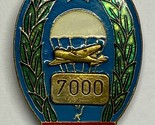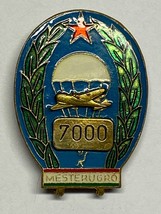Rendered at 12:24:53 05/24/25
HUNGARY, MASTER, PARACHUTIST, PARA WING, COMMUNIST ERA, 7000 JUMPS, B&T 2204
$870.21 MXN
Los buques de
United States

Las opciones de envío
Los buques de 1 business day Detalles
No hay precio de envío se especifica en MX
Los buques de
United States

La política de devoluciones
Full refund available within 30 days
Detalles
Protección de compra
Opciones de pago
PayPal accepted
PayPal Credit accepted
Venmo accepted
PayPal, MasterCard, Visa, Discover, and American Express accepted
Maestro accepted
Amazon Pay accepted
Nuvei accepted
Las opciones de envío
Los buques de 1 business day Detalles
No hay precio de envío se especifica en MX
Los buques de
United States

La política de devoluciones
Full refund available within 30 days
Detalles
Protección de compra
Opciones de pago
PayPal accepted
PayPal Credit accepted
Venmo accepted
PayPal, MasterCard, Visa, Discover, and American Express accepted
Maestro accepted
Amazon Pay accepted
Nuvei accepted
Rasgos del artículo
| Categoría: | |
|---|---|
| cantidad disponible: |
Sólo uno en stock, para muy pronto |
| Condition: |
Used |
| Country/Region of Manufacture: |
Hungary |
| Type: |
Badge |
| Theme: |
Militaria |
Detalles del anuncio
| Las políticas del vendedor: | |
|---|---|
| Envío de descuento: |
No ofrece el envío combinado |
| Publicado en venta: |
May 1 |
| Artículo número: |
1743626913 |
Descripción del Artículo
HUNGARY, MASTER, PARACHUTIST, PARA WING, COMMUNIST ERA, 7000 JUMPS, B T 2204, VINTAGE
Communist time period which is designated by the red star at the top of the badge.
Original, Vintage, Para Wings. No chips to the enamels.
The history of Hungarian airborne forces can be broadly divided into three phases:
1. World War II (1939-1945):
1939: Following the example of other European nations, Hungary established its first airborne unit, the 1st Parachute Battalion.
1944: The battalion was expanded into the 1st Parachute Regiment.
Limited combat involvement: These paratroopers saw limited action during World War II, primarily engaging in defensive operations against the advancing Soviet forces.
2. Cold War Era (1945-1989):
Post-war re-establishment: After the war, the airborne unit was disbanded but re-established in 1948 as a parachute company.
Expansion and Soviet influence: During the Cold War, under Soviet influence, the company grew into the 62nd Parachute Battalion within the Hungarian People's Army.
Training and exercises: The battalion primarily focused on training and participating in exercises with other Warsaw Pact forces, but it did not see any active combat.
3. Post-Cold War Era (1990-present):
Downsizing and shift: After the fall of the Soviet Union and Hungary's integration with NATO, the 62nd Parachute Battalion was disbanded in the late 1990s.
Focus on special forces: Since then, Hungary's focus in terms of air-deployable troops has shifted towards Special Reconnaissance Forces (SRF) within the Hungarian Defence Forces.
No dedicated airborne unit: As of today, Hungary does not maintain a dedicated airborne unit like a parachute regiment. However, some elements within the SRF receive parachute training and are capable of aerial deployment.
While Hungary no longer boasts a large-scale airborne force, its military continues to emphasize rapid deployment capabilities through specialized units like the SRF, reflecting the evolving needs of modern warfare.
Added to your wish list!

- HUNGARY, MASTER, PARACHUTIST, PARA WING, COMMUNIST ERA, 7000 JUMPS, B&T 2204
- 1 in stock
- Handling time 1 day.
- Returns/refunds accepted
Get an item reminder
We'll email you a link to your item now and follow up with a single reminder (if you'd like one). That's it! No spam, no hassle.
Already have an account?
Log in and add this item to your wish list.







